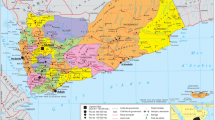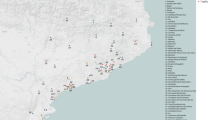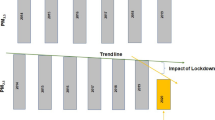Abstract
The rapid development of the Belt and Road Initiative (BRI) has led to severe air pollution dominated by PM2.5 concentrations which can cause a profound negative impact on human health and economic activity. This problem poses a critical environmental challenge to efficiently handling large-scale spatial–temporal PM2.5 data in this extended region. Functional data analysis (FDA) technique offers powerful tools that have the potential to enhance the analysis of spatial distributions and temporal dynamic changes in high-dimensional pollution data. However, modeling the spatial–temporal variability of PM2.5 concentrations by FDA remains unrevealed in the BRI region. To address this research gap, our study aimed to achieve two main objectives: first, to model the spatial–temporal dynamic variability of PM2.5 in 125 BRI nations (1998–2021), and second, to identify the underlying clusters behind the variations. We employed the recently developed functional adaptive density peak (FADP) clustering approach to solve the current problem. The proposed method is based on the joint use of functional principal components (FPCs) and functional cluster analyses. The main results are as follows: (i) The first three FPCs almost captured 99% of the total variations involving all valuable information on PM2.5 concentrations. (ii) PM2.5 pollution was highly concentrated in the developing countries (Pakistan, Bangladesh, and Nigeria) and the developed countries (Arabian Gulf countries: Qatar, United Arab Emirates, Bahrain, Saudi Arabia, Oman), and the least developed countries (Yemen and Chad). (iii) Three optimal clusters were identified and thus classified the PM2.5 into three distinct degrees of pollution: severe, moderate, and light. (iv) Cluster 1 had a severe pollution effect degree with a high rate of change, and it covered the Arabian Peninsula countries, African countries (Cameroon, Egypt, Gambia, Mali, Mauritania, Nigeria, Sudan, Senegal, Chad), Bangladesh, and Pakistan. (v) About 62 BRI countries belonged to cluster 2 showing a light pollution degree with annul average of less than 20 \(\mathrm{\mu g}/{\mathrm{m}}^{3}\); this pointed out that the PM2.5 concentration remains stable in the cluster 2–related countries. The findings of this research would benefit governments and policymakers in preventing and controlling PM2.5 pollution exposure in BRI. Furthermore, this research could pay attention to sustainable development goals and the vision of the Green BRI policy.











Similar content being viewed by others
Data availability
Data are accessible from the corresponding author upon request.
References
Acal C, Aguilera AM, Sarra A, Evangelista A, Di Battista T, Palermi S (2022) Functional ANOVA approaches for detecting changes in air pollution during the COVID-19 pandemic. Stoch Env Res Risk Assess 36(4):1083–1101. https://doi.org/10.1007/s00477-021-02071-4
Alfiandy S, Virgianto RH, Putri AS (2020) Modeling of daily PM2.5 concentration based on the principal components regression in south and central Jakarta. J Phys: Conference Series 1434(1). https://doi.org/10.1088/1742-6596/1434/1/012012
Anjum MS, Ali SM, Imad-ud-din M, Subhani MA, Anwar MN, Nizami AS, Ashraf U, Khokhar MF (2021) An emerged challenge of air pollution and ever-increasing particulate matter in Pakistan; a critical review. J Hazard Mater 402(June 2020). https://doi.org/10.1016/j.jhazmat.2020.123943
Ascensão F, Fahrig L, Clevenger AP, Corlett RT, Jaeger JAG, Laurance WF, Pereira HM (2018) Environmental challenges for the Belt and Road Initiative. Nat Sustain 1(5):206–209. https://doi.org/10.1038/s41893-018-0059-3
Broomandi P, Geng X, Guo W, Pagani A, Topping D, Kim JR (2021) Dynamic complex network analysis of PM2.5 concentrations in the Uk, using hierarchical directed graphs (V1.0.0). Sustainability 13(4):1–14. https://doi.org/10.3390/su13042201
Delaigle A, Hall P (2010) Defining Probability Density for a Distribution of Random Functions. Ann Stat 38(2):1171–1193. https://doi.org/10.1214/09-AOS741
Fang K, Wang T, He J, Wang T, Xie X, Tang Y, Shen Y, Xu A (2020) The distribution and drivers of PM2.5 in a rapidly urbanizing region: the Belt and Road Initiative in focus. Sci Total Environ 716:137010. https://doi.org/10.1016/j.scitotenv.2020.137010
Fattah MdA, Morshed SR, Al Kafy A, Rahaman ZA, Rahman MT (2023) Wavelet coherence analysis of PM2.5 variability in response to meteorological changes in South Asian Cities. Atmos Pollut Res 14(5). https://doi.org/10.1016/j.apr.2023.101737
Ferraty F, Vieu P (2006) Nonparametric functional data analysis: theory and practice. New York: Springer Series in Statistics. https://doi.org/10.1007/0-387-36620-2
Gao S, Zhao H, Bai Z, Han B, Xu J, Zhao R, Zhang N, Chen L, Lei X, Shi W, Zhang L, Li P, Yu H (2020) Combined use of principal component analysis and artificial neural network approach to improve estimates of PM2.5 personal exposure: a case study on older adults. Sci Total Environ 726:138533. https://doi.org/10.1016/j.scitotenv.2020.138533
Giacosa G, Rainham GD, Walker TR (2023) A baseline characterization of fine particulate matter (PM2.5) concentration and releases in Nova Scotia, Canada. Atmos Pollut Res 14(5). https://doi.org/10.1016/j.apr.2023.101757
Hael MA (2023) Unbiased recursive decision tree for supervised functional data classification with applying on electrocardiogram signals. Int J Data Sci Anal. https://doi.org/10.1007/s41060-023-00410-y
Hael MA (2023) Unveiling air pollution patterns in Yemen : a spatial – temporal functional data analysis. Environ Sci Pollut Res. https://doi.org/10.1007/s11356-023-25790-3
Hael MA, Ma HQ, AL-kuhali HA, Rizk Z (2023) Quantile-based clustering for functional data via modelling functional principal components scores. J Phys: Conference Series 2449(1):012016. https://doi.org/10.1088/1742-6596/2449/1/012016
Hael MA (2020) Modeling of rainfall variability using functional principal component method : a case study of Taiz Region, Yemen. Model Earth Syst Environ (2014). https://doi.org/10.1007/s40808-020-00876-w
He C, Li B, Gong X, Liu L, Li H, Zhang L, Jin J (2023) Spatial-temporal evolution patterns and drivers of PM2.5 chemical fraction concentrations in China over the past 20 years. Environ Sci Pollut Res. https://doi.org/10.1007/s11356-023-28913-y
Jacques J, Preda C (2014) Functional data clustering: a survey. Adv Data Anal Classif 8(3):231–255. https://doi.org/10.1007/s11634-013-0158-y
Jin Y, Andersson H, Zhang S (2016) Air pollution control policies in China: a retrospective and prospects. Int J Environ Res Public Health 13(12). https://doi.org/10.3390/ijerph13121219
Jorquera H, Villalobos AM (2020) Combining cluster analysis of air pollution and meteorological data with receptor model results for ambient Pm2.5 and Pm10. Int J Environ Res Public Health 17(22):1–25. https://doi.org/10.3390/ijerph17228455
Karimi B, Shokrinezhad B (2021) Spatial variation of ambient PM2.5 and PM10 in the industrial city of Arak, Iran: A Land-Use Regression. Atmos Pollut Res 12(12):101235
King MC, Staicu AM, Davis JM, Reich BJ, Eder B (2018) A functional data analysis of spatiotemporal trends and variation in fine particulate matter. Atmos Environ 184:233–243. https://doi.org/10.1016/j.atmosenv.2018.04.001
Li S, Sedra S, Zou B, Liu J, Xiong Y, Muhammad B (2022) PM2.5 concentration exposure over the Belt and Road Region from 2000 to 2020. Int J Environ Res Public Health 19(5). https://doi.org/10.3390/ijerph19052852
Li Y, Qiu Y, Xu Y (2022) From multivariate to functional data analysis: fundamentals, recent developments, and emerging areas. J Multivar Anal 188:104806. https://doi.org/10.1016/j.jmva.2021.104806
Liang D, Zhang H, Chang X, Huang H (2021) Modeling and regionalization of China’s PM2.5 using spatial-functional mixture models. J Am Stat Assoc 116(533):116–132. https://doi.org/10.1080/01621459.2020.1764363
Liew HP, Eidem N (2022) Assessing the spatial-temporal clustering and health implications of fine particulate matter (PM2.5). J Public Health 30(4):789–799
Lim CH, Ryu J, Choi Y, Jeon SW, Lee WK (2020) Understanding global PM2.5 concentrations and their drivers in recent decades (1998–2016). Environ Int 144(March):106011. https://doi.org/10.1016/j.envint.2020.106011
Linh N, Ngoc T, Pimonsree S, Thao PTB, Vongruang P (2022) Public health and economic impact assessment of PM2.5 from open biomass burning over countries in Mainland Southeast Asia during the smog episode. Atmos Pollut Res 13(6):101418. https://doi.org/10.1016/j.apr.2022.101418
Liu W, Song Z, Liu Z, Yeerken W, Song T, Niu F, Han M (2018) Progress in research on the Belt and Road Initiative. Acta Geographica Sinica 73(4):620–36. https://doi.org/10.11821/dlxb201804003
Liu H, Long Z, Duan Z, Shi H (2020) A new model using multiple feature clustering and neural networks for forecasting hourly PM2.5 concentrations, and its applications in China. Engineering 6(8):944–956. https://doi.org/10.1016/j.eng.2020.05.009
Mukherjee A, Agrawal M (2018) Assessment of local and distant sources of urban PM2.5 in middle Indo-Gangetic Plain of India using statistical modeling. Atmos Res 213:275–287. https://doi.org/10.1016/j.atmosres.2018.06.014
Nouri A, Lak MG, Valizadeh M (2021) Prediction of PM2.5 concentrations using principal component analysis and artificial neural network techniques: a case study: Urmia, Iran. Environ Eng Sci 38(2):89–98. https://doi.org/10.1089/ees.2020.0089
Park JM, Lee TJ, Kim DS (2022) Improving PMF source reconciliation with cluster analysis for PM2.5 hourly data from Seoul, Korea. Atmos Pollut Res 13(5). https://doi.org/10.1016/j.apr.2022.101398
Qi G, Wang Z, Wei L, Wang Z (2022) Multidimensional effects of urbanization on PM2.5 concentration in China. Environ Sci Pollut Res 29(51):77081–77096. https://doi.org/10.1007/s11356-022-21298-4
Ramsay JO, Silverman BW (2005) Functional data analysis. Springer Series in Statistics, New York. https://doi.org/10.1007/b98888
Ramsay JO, Wickham H, Graves S, Hooker G (2022) Fda: functional data analysis. R Package Version 6.0.5. https://cran.rproject.org/Package=fda. Accessed 2 April 2023
Ren R, Fang K, Zhang Q, Wang X (2022) FADPclust: functional data clustering using adaptive density peak detection. R Package Version 1.0.1. https://cran.rproject.org/Package=FADPclust. Accessed 20 Mar 2023.
Ren R, Fang K, Zhang Q, Wang X (2023) Multivariate functional data clustering using adaptive density peak detection. Stat Med (February):1–18. https://doi.org/10.1002/sim.9687
Rousseeuw PJ (1987) Silhouettes: a graphical aid to the interpretation and validation of cluster analysis. J Comput Appl Math 20:53–65
R Core Team (2018) R: A language and environment for statistical computing. R Foundation for Statistical Computing, Vienna. https://www.R-project.org
Sabetghadam S, Alizadeh O, Khoshsima M, Pierleoni A (2021) Aerosol properties, trends and classification of key types over the Middle East from satellite-derived atmospheric optical data. Atmos Environ 246(November 2020):118100. https://doi.org/10.1016/j.atmosenv.2020.118100
Shi G, Liu J, Zhong X (2022) Spatial and temporal variations of PM2.5 concentrations in Chinese cities during 2015–2019. Int J Environ Health Res 32(12):2695–2707. https://doi.org/10.1080/09603123.2021.1987394
Southerland VA, Brauer M, Mohegh A, Hammer MS, van Donkelaar A, Martin RV, Apte JS, Anenberg SC (2022) Global urban temporal trends in fine particulate matter (PM2·5) and attributable health burdens: estimates from global datasets. Lancet Planet Health 6(2):e139–e146. https://doi.org/10.1016/S2542-5196(21)00350-8
Sun X, Zhang R, Wang G (2022) Spatial-temporal evolution of health impact and economic loss upon exposure to PM2.5 in China. Int J Environ Res Public Health 19(4). https://doi.org/10.3390/ijerph19041922
Taghavi M, Ghanizadeh G, Ghasemi M, Fassò A, Hoek G, Hushmandi K, Raei M (2023) Application of functional principal component analysis in the spatiotemporal land-use regression modeling of PM2.5. Atmosphere 14(6):926. https://doi.org/10.3390/atmos14060926
Wang H, Ge Qi (2023) Spatial association network of PM2.5 and its influencing factors in the Beijing–Tianjin–Hebei urban agglomeration. Environ Sci Pollut Res 30(27):70541–70557
Wang Q, Kwan MP, Zhou K, Fan J, Wang Y, Zhan D (2019) The impacts of urbanization on fine particulate matter (PM2.5) concentrations: empirical evidence from 135 countries worldwide. Environ Pollut 247:989–998. https://doi.org/10.1016/j.envpol.2019.01.086
Wang W, Samat A, Abuduwaili J, Ge Y (2020) Spatio-temporal variations of satellite-based PM2.5 concentrations and its determinants in Xinjiang, Northwest of China. Int J Environ Res Public Health 17(6):1–24. https://doi.org/10.3390/ijerph17062157
Wang J, Liu D, Xijie Xu, Ma J, Han L (2022) Analysis of the temporal and spatial pattern of air pollution and the heterogeneity of its influencing factors in Central Inner Mongolia from 2016 to 2018. Front Environ Sci 10(August):1–15. https://doi.org/10.3389/fenvs.2022.893437
Wang D, Zhong Z, Bai K, He L (2019) Spatial and temporal variabilities of PM2.5 concentrations in China using functional data analysis. Sustainability 11(6). https://doi.org/10.3390/su11061620
Wang X, Li T, Ikhumhen HO, Sá R (2022) Spatio-temporal variability and persistence of PM2.5 concentrations in China using trend analysis methods and hurst exponent. Atmos Pollut Res 13(1). https://doi.org/10.1016/j.apr.2021.101274
Wei G, Zhang Z, Ouyang X, Shen Y, Jiang S, Liu B, He BJ (2021) Delineating the spatial-temporal variation of air pollution with urbanization in the Belt and Road Initiative Area. Environ Impact Assess Rev 91(July):106646. https://doi.org/10.1016/j.eiar.2021.106646
Wen W, Su Y, Liu LJ, He YJ (2023) Embodied industrial PM2.5-related health impact flows and economic benefits of the Belt and Road Initiative towards China. J Clean Prod 395:136365. https://doi.org/10.1016/j.jclepro.2023.136365
Wongnakae P, Chitchum P, Sripramong R, Phosri A (2023) Application of satellite remote sensing data and random forest approach to estimate ground-level PM2.5 concentration in Northern Region of Thailand. Environ Sci Pollut Res. https://doi.org/10.1007/s11356-023-28698-0
Xu W, Wang Y, Sun S, Yao L, Li T, Xuecheng Fu (2022) Spatiotemporal heterogeneity of PM2.5 and its driving difference comparison associated with urbanization in China’s multiple urban agglomerations. Environ Sci Pollut Res 29(20):29689–29703
Yang Z, Mahendran R, Pei Yu, Rongbin Xu, Wenhua Yu, Godellawattage S, Li S, Guo Y (2022) Health effects of long-term exposure to ambient PM2.5 in Asia-Pacific: a systematic review of cohort studies. Curr Environ Health Rep 9(2):130–151. https://doi.org/10.1007/s40572-022-00344-w
Zhou De, Lin Z, Liu L, Qi J (2021) Spatial-temporal characteristics of urban air pollution in 337 Chinese cities and their influencing factors. Environ Sci Pollut Res 28(27):36234–36258. https://doi.org/10.1007/s11356-021-12825-w
Zhu M, Guo J, Zhou Y, Cheng X (2022) Exploring the spatiotemporal evolution and socioeconomic determinants of PM2. 5 Distribution and Its Hierarchical Management Policies in 366 Chinese Cities. Front Public Health 10(March):1–14. https://doi.org/10.3389/fpubh.2022.843862
Author information
Authors and Affiliations
Corresponding author
Ethics declarations
Ethical approval
Not applicable.
Consent to participate
Not applicable.
Consent to publish
The author consents to publish this manuscript.
Competing interests
The author declares no competing interests.
Additional information
Responsible Editor: Marcus Schulz
Publisher's Note
Springer Nature remains neutral with regard to jurisdictional claims in published maps and institutional affiliations.
Rights and permissions
Springer Nature or its licensor (e.g. a society or other partner) holds exclusive rights to this article under a publishing agreement with the author(s) or other rightsholder(s); author self-archiving of the accepted manuscript version of this article is solely governed by the terms of such publishing agreement and applicable law.
About this article
Cite this article
Hael, M.A. Modeling spatial–temporal variability of PM2.5 concentrations in Belt and Road Initiative (BRI) region via functional adaptive density approach. Environ Sci Pollut Res 30, 110931–110955 (2023). https://doi.org/10.1007/s11356-023-30048-z
Received:
Accepted:
Published:
Issue Date:
DOI: https://doi.org/10.1007/s11356-023-30048-z




